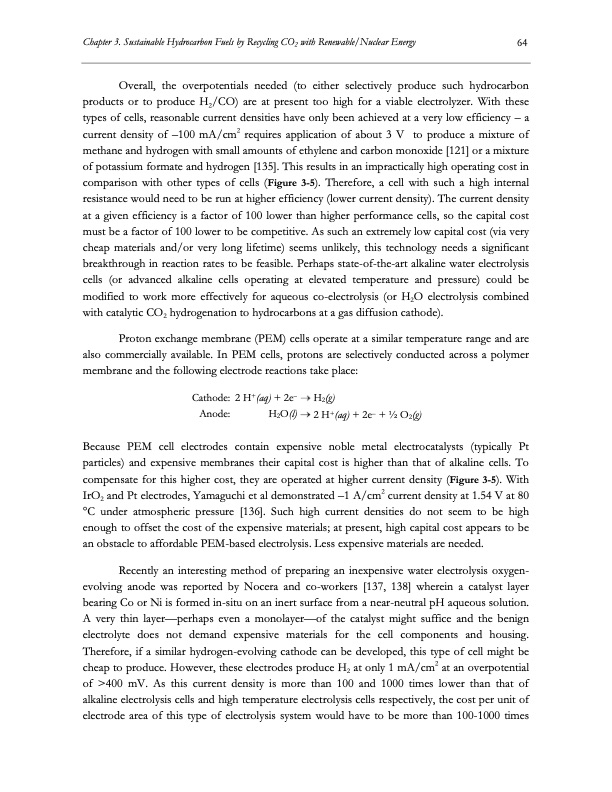
PDF Publication Title:
Text from PDF Page: 085
Chapter 3. Sustainable Hydrocarbon Fuels by Recycling CO2 with Renewable/Nuclear Energy 64 Overall, the overpotentials needed (to either selectively produce such hydrocarbon products or to produce H2/CO) are at present too high for a viable electrolyzer. With these types of cells, reasonable current densities have only been achieved at a very low efficiency – a current density of –100 mA/cm2 requires application of about 3 V to produce a mixture of methane and hydrogen with small amounts of ethylene and carbon monoxide [121] or a mixture of potassium formate and hydrogen [135]. This results in an impractically high operating cost in comparison with other types of cells (Figure 3-5). Therefore, a cell with such a high internal resistance would need to be run at higher efficiency (lower current density). The current density at a given efficiency is a factor of 100 lower than higher performance cells, so the capital cost must be a factor of 100 lower to be competitive. As such an extremely low capital cost (via very cheap materials and/or very long lifetime) seems unlikely, this technology needs a significant breakthrough in reaction rates to be feasible. Perhaps state-of-the-art alkaline water electrolysis cells (or advanced alkaline cells operating at elevated temperature and pressure) could be modified to work more effectively for aqueous co-electrolysis (or H2O electrolysis combined with catalytic CO2 hydrogenation to hydrocarbons at a gas diffusion cathode). Proton exchange membrane (PEM) cells operate at a similar temperature range and are also commercially available. In PEM cells, protons are selectively conducted across a polymer membrane and the following electrode reactions take place: Cathode: 2 H+(aq) + 2e– H2(g) Anode: H2O(l) 2 H+(aq) + 2e– + 1⁄2 O2(g) Because PEM cell electrodes contain expensive noble metal electrocatalysts (typically Pt particles) and expensive membranes their capital cost is higher than that of alkaline cells. To compensate for this higher cost, they are operated at higher current density (Figure 3-5). With IrO2 and Pt electrodes, Yamaguchi et al demonstrated –1 A/cm2 current density at 1.54 V at 80 °C under atmospheric pressure [136]. Such high current densities do not seem to be high enough to offset the cost of the expensive materials; at present, high capital cost appears to be an obstacle to affordable PEM-based electrolysis. Less expensive materials are needed. Recently an interesting method of preparing an inexpensive water electrolysis oxygen- evolving anode was reported by Nocera and co-workers [137, 138] wherein a catalyst layer bearing Co or Ni is formed in-situ on an inert surface from a near-neutral pH aqueous solution. A very thin layer—perhaps even a monolayer—of the catalyst might suffice and the benign electrolyte does not demand expensive materials for the cell components and housing. Therefore, if a similar hydrogen-evolving cathode can be developed, this type of cell might be cheap to produce. However, these electrodes produce H2 at only 1 mA/cm2 at an overpotential of >400 mV. As this current density is more than 100 and 1000 times lower than that of alkaline electrolysis cells and high temperature electrolysis cells respectively, the cost per unit of electrode area of this type of electrolysis system would have to be more than 100-1000 timesPDF Image | Electrolysis of CO2 and H2O

PDF Search Title:
Electrolysis of CO2 and H2OOriginal File Name Searched:
co2-hso-fuels.pdfDIY PDF Search: Google It | Yahoo | Bing
NFT (Non Fungible Token): Buy our tech, design, development or system NFT and become part of our tech NFT network... More Info
IT XR Project Redstone NFT Available for Sale: NFT for high tech turbine design with one part 3D printed counter-rotating energy turbine. Be part of the future with this NFT. Can be bought and sold but only one design NFT exists. Royalties go to the developer (Infinity) to keep enhancing design and applications... More Info
Infinity Turbine IT XR Project Redstone Design: NFT for sale... NFT for high tech turbine design with one part 3D printed counter-rotating energy turbine. Includes all rights to this turbine design, including license for Fluid Handling Block I and II for the turbine assembly and housing. The NFT includes the blueprints (cad/cam), revenue streams, and all future development of the IT XR Project Redstone... More Info
Infinity Turbine ROT Radial Outflow Turbine 24 Design and Worldwide Rights: NFT for sale... NFT for the ROT 24 energy turbine. Be part of the future with this NFT. This design can be bought and sold but only one design NFT exists. You may manufacture the unit, or get the revenues from its sale from Infinity Turbine. Royalties go to the developer (Infinity) to keep enhancing design and applications... More Info
Infinity Supercritical CO2 10 Liter Extractor Design and Worldwide Rights: The Infinity Supercritical 10L CO2 extractor is for botanical oil extraction, which is rich in terpenes and can produce shelf ready full spectrum oil. With over 5 years of development, this industry leader mature extractor machine has been sold since 2015 and is part of many profitable businesses. The process can also be used for electrowinning, e-waste recycling, and lithium battery recycling, gold mining electronic wastes, precious metals. CO2 can also be used in a reverse fuel cell with nafion to make a gas-to-liquids fuel, such as methanol, ethanol and butanol or ethylene. Supercritical CO2 has also been used for treating nafion to make it more effective catalyst. This NFT is for the purchase of worldwide rights which includes the design. More Info
NFT (Non Fungible Token): Buy our tech, design, development or system NFT and become part of our tech NFT network... More Info
Infinity Turbine Products: Special for this month, any plans are $10,000 for complete Cad/Cam blueprints. License is for one build. Try before you buy a production license. May pay by Bitcoin or other Crypto. Products Page... More Info
| CONTACT TEL: 608-238-6001 Email: greg@infinityturbine.com | RSS | AMP |